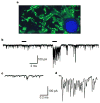Calcium dependence of spontaneous neurotransmitter release
- PMID: 28699241
- PMCID: PMC5766384
- DOI: 10.1002/jnr.24116
Calcium dependence of spontaneous neurotransmitter release
Abstract
Spontaneous release of neurotransmitters is regulated by extracellular [Ca2+ ] and intracellular [Ca2+ ]. Curiously, some of the mechanisms of Ca2+ signaling at central synapses are different at excitatory and inhibitory synapses. While the stochastic activity of voltage-activated Ca2+ channels triggers a majority of spontaneous release at inhibitory synapses, this is not the case at excitatory nerve terminals. Ca2+ release from intracellular stores regulates spontaneous release at excitatory and inhibitory terminals, as do agonists of the Ca2+ -sensing receptor. Molecular machinery triggering spontaneous vesicle fusion may differ from that underlying evoked release and may be one of the sources of heterogeneity in release mechanisms.
Keywords: VGCC (voltage-gated calcium channels); calcium; minis; spontaneous release.
Published 2017. This article is a U.S. Government work and is in the public domain in the USA.
Figures




References
Publication types
MeSH terms
Substances
Grants and funding
LinkOut - more resources
Full Text Sources
Other Literature Sources
Miscellaneous

